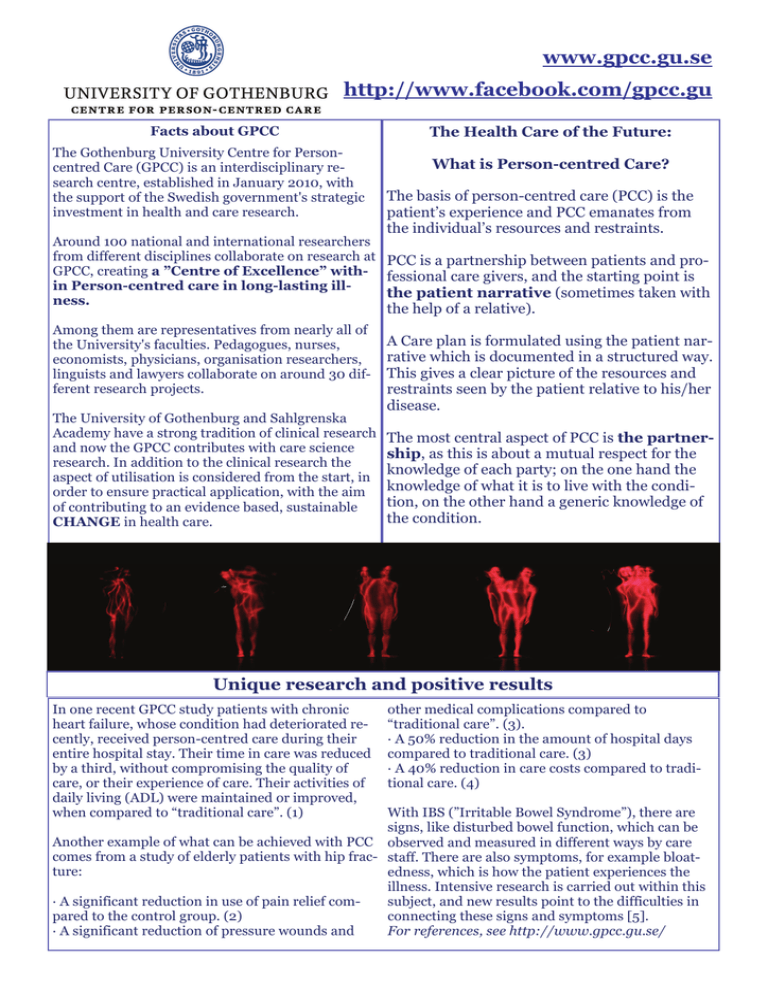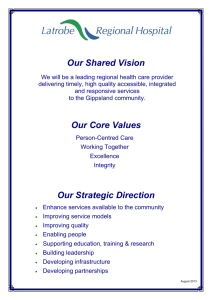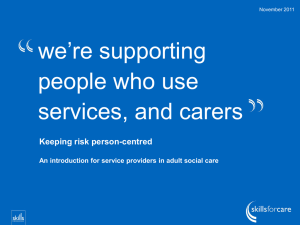www.gpcc.gu.se http://www.facebook.com/gpcc.gu
advertisement

www.gpcc.gu.se http://www.facebook.com/gpcc.gu Facts about GPCC The Gothenburg University Centre for Personcentred Care (GPCC) is an interdisciplinary research centre, established in January 2010, with the support of the Swedish government's strategic investment in health and care research. The Health Care of the Future: What is Person-centred Care? The basis of person-centred care (PCC) is the patient’s experience and PCC emanates from the individual’s resources and restraints. Around 100 national and international researchers from different disciplines collaborate on research at PCC is a partnership between patients and proGPCC, creating a ”Centre of Excellence” with- fessional care givers, and the starting point is in Person-centred care in long-lasting illthe patient narrative (sometimes taken with ness. the help of a relative). Among them are representatives from nearly all of the University's faculties. Pedagogues, nurses, economists, physicians, organisation researchers, linguists and lawyers collaborate on around 30 different research projects. The University of Gothenburg and Sahlgrenska Academy have a strong tradition of clinical research and now the GPCC contributes with care science research. In addition to the clinical research the aspect of utilisation is considered from the start, in order to ensure practical application, with the aim of contributing to an evidence based, sustainable CHANGE in health care. A Care plan is formulated using the patient narrative which is documented in a structured way. This gives a clear picture of the resources and restraints seen by the patient relative to his/her disease. The most central aspect of PCC is the partnership, as this is about a mutual respect for the knowledge of each party; on the one hand the knowledge of what it is to live with the condition, on the other hand a generic knowledge of the condition. Unique research and positive results In one recent GPCC study patients with chronic heart failure, whose condition had deteriorated recently, received person-centred care during their entire hospital stay. Their time in care was reduced by a third, without compromising the quality of care, or their experience of care. Their activities of daily living (ADL) were maintained or improved, when compared to “traditional care”. (1) other medical complications compared to “traditional care”. (3). · A 50% reduction in the amount of hospital days compared to traditional care. (3) · A 40% reduction in care costs compared to traditional care. (4) With IBS (”Irritable Bowel Syndrome”), there are signs, like disturbed bowel function, which can be Another example of what can be achieved with PCC observed and measured in different ways by care comes from a study of elderly patients with hip frac- staff. There are also symptoms, for example bloatture: edness, which is how the patient experiences the illness. Intensive research is carried out within this · A significant reduction in use of pain relief comsubject, and new results point to the difficulties in pared to the control group. (2) connecting these signs and symptoms [5]. · A significant reduction of pressure wounds and For references, see http://www.gpcc.gu.se/ www.gpcc.gu.se http://www.facebook.com/gpcc.gu What is happening within the GPCC right now? GPCC has a large number of on-going activities on all fronts. Apart from on-going research within about 30 projects, the centre is putting its knowledge and experience into practical use through innovation/utilisation as well as spreading it’s knowledge through education. Innovation/Utilisation Education Package National Reference Ward Person-centred care in practice PVP Together with collaboration partners from Sahlgrenska University Hospital, Region Västra Götaland, and Industry partners IBM, Astra Zeneca and Doberman, GPCC have received initial funding of 3 million SEK? during 2012-13 from Vinnova, Swedish Governmental Agency for Innovation Systems. Vinnova’s assessment of the project ”Person-centred Care” is that it has good chances of resulting in new innovative solutions with great potential of demonstrating how a change to effective high quality health care can be made. The project, which is called ” National Reference Ward for Person-centred Care (NATREF PCV)” aims to develop the person-centred health care ward of the future, and also be an open and sustainable testbed for new care forms, services and products such as education, ehealth and IT solutions. NATREF PCV constitutes a reference point for the health care of the future, both nationally and internationally through identifying, developing and integrating partial solutions for a change in health care. Vinnova’s project reference number 2012-03996 GPCC tailor makes educational packages for different environments. In order to achieve a change to personcentred health care sweeping changes of both culture and structure are needed. The aim of the educational programme is to establish a sustainable person-centred way of working which permeates the entire care process resting on three foundations: partnership, narrative and documentation. The model for the programme is gathered partly from evidence based person-centred theory, and partly from change theory. Each programme is tailor made from the needs of the individual unit. The programme aims to be effective on both a user and organisational level. User level effects • A deeper understanding of what person-centred care means and how it can be applied in practice. • Developed working methods for planning and systematically carrying out person-centred care for patients with varying medical conditions and care needs. • The ability to establish partnerships with patients and to create a health care plan from a person-centred perspective. Project Manager: Axel Wolf GPCC works continually with stakeholders within industry, official and private care givers, regional and national innovations systems and international development partners to identify sustainable and scaleable means of carrying out evidence based person-centred care in order to improve care processes. For further information please contact: Axel Wolf, axel.wolf@gu.se, Telephone: +46317866034, Mobile: Utilisation vision: Organisation level effects • Consensus enshrined in the concept personcentredness. • To have identified resources and restraints to instating a model for person-centred care in the individual care unit. • A plan for further work. The model constitutes of change management work happening on three consecutive levels; management, among strategic ”change agents” and with the involvement of all co-workers. make sure official and commercial operators have a common ground for improving an active and informed patient participation in the care process. • Better care for people with chronic and long-term conditions By developing and realising person-centred care processes GPCC will collaborate with official and commercial operators in • Creating a continuous care chain creating new possibilities for improved care in long-term illThrough an increased usage of innovations and health inforness, thus relieving increasingly strained health care systems. matics, care giver and patient education, as well as organisational and structural changes for care givers, GPCC will be able • Increasing the person’s participation in care process- to guarantee the use of models and concrete solutions to create es a joined-up care chain which can flexibly hold organisations, Through a deepened understanding of self-reporting and selfcare givers, commercial operators, relatives and societies, as diagnosing, together with developing new models and process- well as the person in the centre of the care process. es for evaluating and improving patient satisfaction, GPCC will




